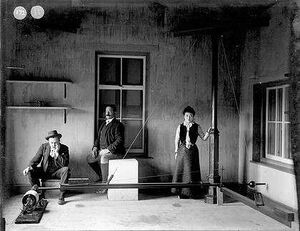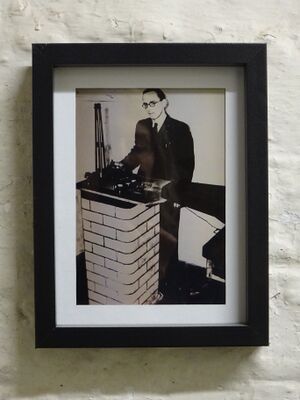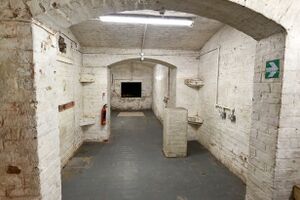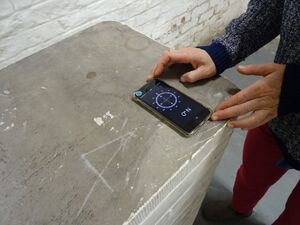Vertical Pendulum Tilt Meter
"The Observatory’s two levels of cellars and other features made it especially suited for calibrating chronometers under controlled conditions of temperature and seismic vibrations."[1]
"[A] new activity commenced in 1897 with the installation in the cellars of a seismograph. This was the first of a series of seismographs of different designs that followed."[2]
Reading and changing the seismographic records was part of the daily routine in Bidston Observatory.[3]
"In 1900 Bidston obtained its own Milne-Seismograph. and tables of its observations were published from 1901." [4]
"The Dock Board felt that 'meteorological observations could be taken with equal accuracy elsewhere' and the Dock Board's 'interest in the unfelt tremors of the earth was not immediate'."[5]
"In 1910, observations were made using instruments designed by Sir George Darwin, Sir Horace Darwin and others to determine the yielding of the land to the load of tidal water, now called the ‘ocean loading effect’."[2]
Could this be the Prof J. A. Ewing’s Seismograph produced by Horace Darwin?[6]
"As a result of the successful tests with the Claustral Pendulum, Bidston acquired a Graf-Askania vertical pendulum of its own, and installed it after modification." [7]
Claustral Pendulum = encased pendulum? A 'Graf-Askania vertical pendulum' or 'gravimeter' or 'Askania vertical pendulum tiltmeter' measures tilt through changes in gravity (which is linked to measuring tidal load but I do not understand yet how).
"New tidal tilt observations were made in the Bidston cellar in the 1930s. Doodson and Corkan (1934) used a Milne-Shaw seismometer for one month of observations. In 1934, funds were used from a Cambridge mathematics prize that was awarded to Proudman to purchase a new Milne-Shaw seismometer. Beginning in March 1935, one year of observations of the north-south tilt were made using this instrument (Corkan, 1939)."[2]
"Geoff Lennon made further observations of the north-south tilt at Bidston using the Milne-Shaw seismometer between 1952 and 1954. For the International Geophysical Year 1957-1958 there were increased efforts to make observations of Earth tides around the world."[2]
"In the Bidston cellar, modified Milne-Shaw seismometers were used to measure the tilts in both the north-south and east-west directions from July 1957 to December 1958 (Lennon, 1959)."[2]
"The Bidston cellar provided a useful test site for comparing various tiltmeters, before installation in the tunnel at Llanrwst."[2]
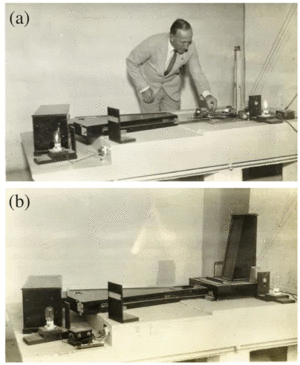
The Milne-Shaw Tilt Meter (or maybe there was more than one?) was transferred to the University of Aberdeen in 1997.
"The NSA (National Seismographic Archive) holds the ex-Bidston Milne-Shaws, examples of modern Willmore instruments, and probably the only Jaggar shockrecorder in existence."[8]
- ↑ Stephen Pickles, A brief history of Bidston Observatory, 2016 http://www.bidstonobservatory.org.uk/a-brief-history-of-bidston-observatory/
- ↑ 2.0 2.1 2.2 2.3 2.4 2.5 Bidston Observatory: Earth Tides and Ocean Tide Loading, Trevor F. Baker, 2 November 2016 http://www.bidstonobservatory.org.uk/earth-tides/
- ↑ Joyce Scoffield, Bidston Observatory, The Place and the People. p172
- ↑ Joyce Scoffield, Bidston Observatory, The Place and the People. p149
- ↑ Joyce Scoffield, Bidston Observatory, The Place and the People. p150
- ↑ https://www.christs.cam.ac.uk/horace-darwin-1851-1928
- ↑ Joyce Scoffield, Bidston Observatory, The Place and the People. p328
- ↑ Historical Seismological Observatories in the British Isles, British Geological Survey, 1999 http://www.earthquakes.bgs.ac.uk/hazard/pdf/wl9913.pdf
